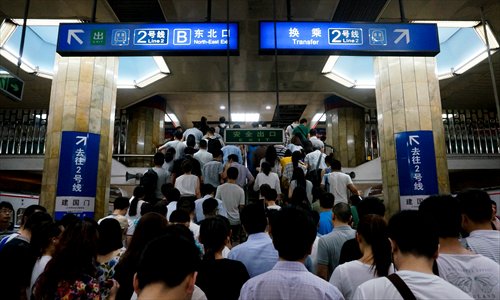HOME >> CHINA
Capital’s population sees shrinking growth amid economic upgrading
By Li Ruohan Source:Global Times Published: 2015-8-24 20:43:01

Crowds at Jianguomen Station on Beijing's subway line 1 on July 14 Photo: CFP
The growth rate of Beijing's population is expected to slow down, analysts said, as the Beijing-Tianjin-Hebei Coordinated Development Program (CDP) moves forward, including the relocation of labor-intensive industries to neighboring areas.
The details of the integrated development program were issued recently, positioning Beijing as the "national center of politics, culture, international exchange and technological innovation," reported the Xinhua News Agency on August 23.
According to a survey from the Beijing Municipal Bureau of Statistics and the National Bureau of Statistics, the permanent population of Beijing was 21.5 million as of December 2014, with the 1.7 percent growth rate being the lowest recorded since 2011.
Industrial changes, tightened residency policies and the fact that overcrowded cities are less livable have all contributed to the slowing of Beijing's population growth rate, experts said.
Regional restructuring
The Beijing-Tianjin-Hebei CDP strategy will see the relocation of Beijing's nonessential functions, which will help adjust the regional economy, nurture new growth sectors, and address problems such as overpopulation, environmental pollution, and resource scarcity, said Xinhua.
Beijing-Tianjin-Hebei integration is not merely about the transfer of industries and population, but also the coordination of policies and resources.
Industries like wholesaling, education and pharmaceuticals have already been transferred outside Beijing, this includes labor intensive businesses such as automobile manufacturing and clothing wholesale markets such as the Zoo Clothing Wholesale Market and Dahongmen Clothing Wholesale Market.
More than 130,000 wholesalers worked in the two markets in December 2014 and the wholesale markets in Beijing's Dongcheng and Xicheng districts have over 200,000 employees, reported the Beijing Times.
Under the plan, Beijing would not be the nation's center of healthcare and education, and related industries will be gradually transferred to neighboring areas.
However, the execution of the CDP is not only a matter of how many people and services Beijing can export, but also a matter of what Tianjin and Hebei can take in, according to Niu Fengrui, an expert on city planning and development at the Chinese Academy of Social Sciences.
Yin Deting, deputy head of the Beijing Population Research Institute, said that by 2020, Beijing will see a significant decrease in migrants and will likely suffer labor shortages, people.com.cn reported in December 2013.
Capital not for everyone
One of the medium-term targets of the Beijing-Tianjin-Hebei CDP is to ensure the permanent population of Beijing is around 23 million by 2020, and to cure Beijing's "urban illnesses" such as air pollution and congestion, said the Xinhua report.
The city's permanent population refers to the number of people living in the area for over six months a year, said NBS spokesman Sheng Laiyun at a press conference in April 2013.
The population of Beijing includes non-Chinese citizens and people whose household registration or hukou is registered outside the capital, who accounted for 38 percent of the city's population in 2014, reported Xinhua in February 2015.
The number of such people moving to Beijing was 374,000, 300,000, 300,000 and 160,000 respectively from 2011 to 2014.
Sheng Guangyao, a researcher with the Chinese Academy of Social Sciences, told the Global Times that it is natural that a city would be less attractive due to heavy traffic, pollution and high house prices, and these factors contribute to fewer people wanting to live in Beijing.
Development in central and western China is soaring due to strong local policy support. Migrant workers need to weigh up the pros and cons of working in China's largest cities versus in less-developed areas that can offer them easier living conditions.
"Housing is cheaper and they enjoy more convenience in their hometown," said Sheng, adding that emotional attachment to the local area and their families also contribute to people staying in their hometowns.
The majority of the migrants are young people, who can help Beijing deal with problems associated with China's aging society. If numbers of young people moving to the city continues to drop, the proportion of Beijing's population in work will get smaller and smaller, said Niu.
Newspaper headline: Beijing slows down
Posted in: Society